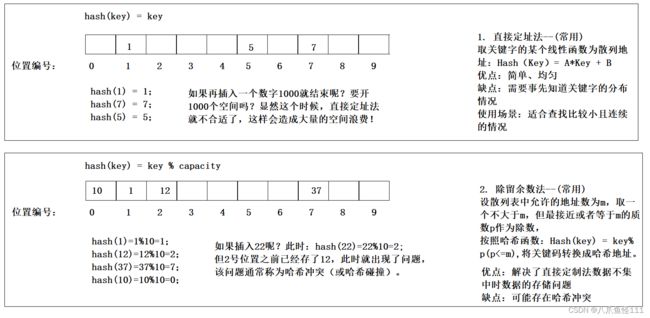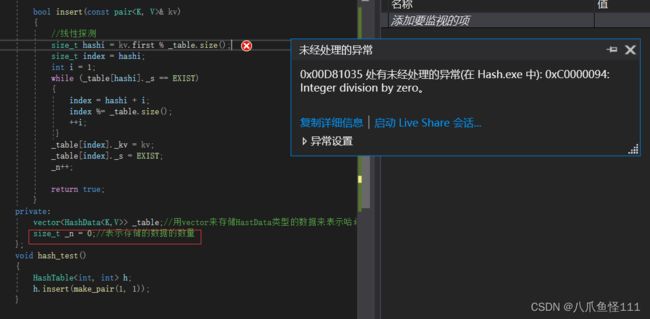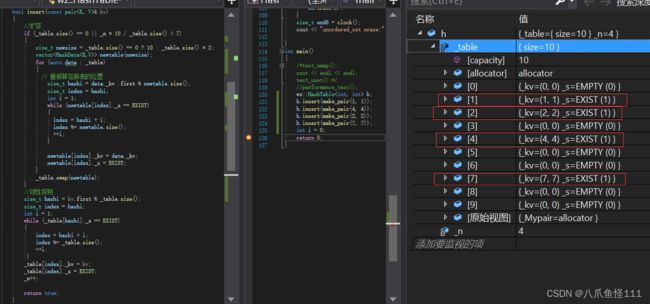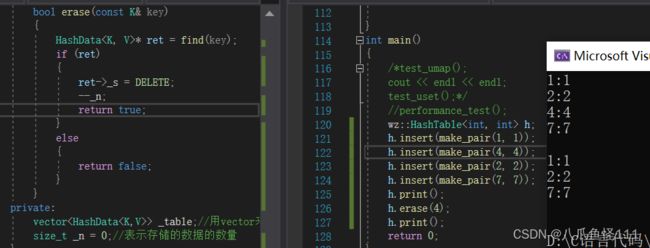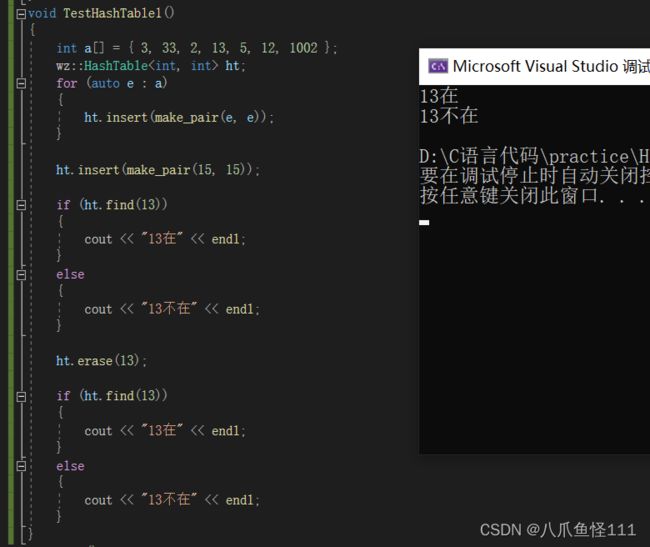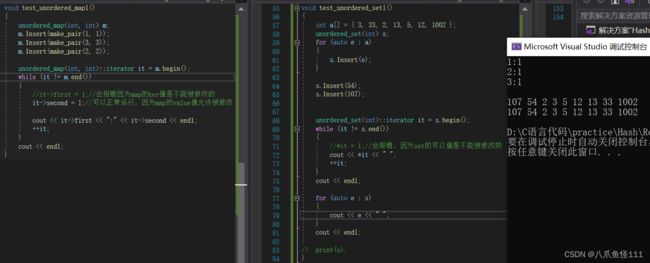【C++进阶:哈希--unordered系列的容器及封装】
本课涉及到的所有代码都见以下链接,欢迎参考指正!
practice: 课程代码练习 - Gitee.comhttps://gitee.com/ace-zhe/practice/tree/master/Hash
unordered系列关联式容器
unordered系列mpa、set和普通map、set区别:
unordered_mpa、unordered_set的简单测试:
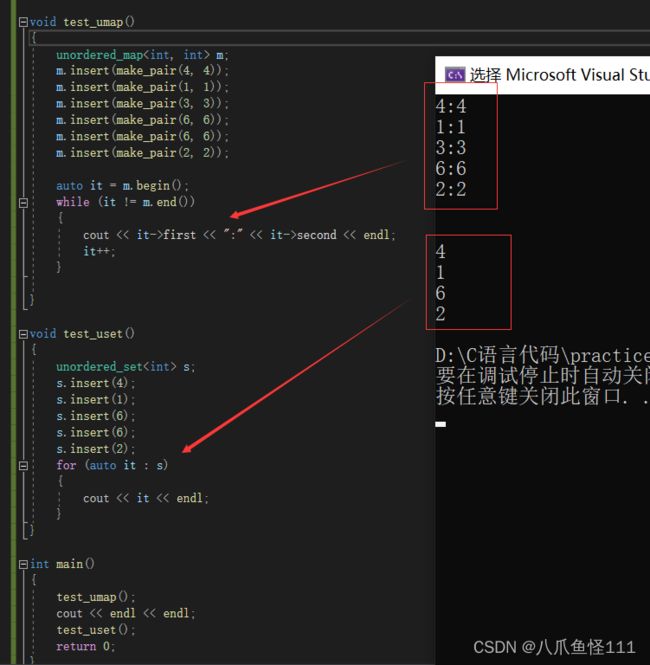 使用时与map、set的基本用法几乎一样,观察发现,unordered系列的关联容器只能完成key值的去重,而不能完成排序,那为什么C++11要搞出这个系列呢?原因是综合考虑后unordered系列的容器基于哈希表底层的特性会使整体操作效率更高,下面我们从几个方面来测试set和unordered_set的性能:
使用时与map、set的基本用法几乎一样,观察发现,unordered系列的关联容器只能完成key值的去重,而不能完成排序,那为什么C++11要搞出这个系列呢?原因是综合考虑后unordered系列的容器基于哈希表底层的特性会使整体操作效率更高,下面我们从几个方面来测试set和unordered_set的性能:
性能测试:
性能测试代码如下(这里我们主要测试插入大量不同形式的随机数,二者性能,足够说明问题):
void performance_test()
{
const size_t N = 100000;
unordered_set us;
set s;
vector v;
v.reserve(N);
srand(time(0));
for (size_t i = 0; i < N; ++i)
{
//v.push_back(rand());
//v.push_back(rand()+i);
v.push_back(i);
}
size_t begin1 = clock();
for (auto e : v)
{
s.insert(e);
}
size_t end1 = clock();
cout << "set insert:" << end1 - begin1 << endl;
size_t begin2 = clock();
for (auto e : v)
{
us.insert(e);
}
size_t end2 = clock();
cout << "unordered_set insert:" << end2 - begin2 << endl << endl;
size_t begin3 = clock();
for (auto e : v)
{
s.find(e);
}
size_t end3 = clock();
cout << "set find:" << end3 - begin3 << endl;
size_t begin4 = clock();
for (auto e : v)
{
us.find(e);
}
size_t end4 = clock();
cout << "unordered_set find:" << end4 - begin4 << endl << endl;
cout << s.size() << endl;
cout << us.size() << endl << endl;;
size_t begin5 = clock();
for (auto e : v)
{
s.erase(e);
}
size_t end5 = clock();
cout << "set erase:" << end5 - begin5 << endl;
size_t begin6 = clock();
for (auto e : v)
{
us.erase(e);
}
size_t end6 = clock();
cout << "unordered_set erase:" << end6 - begin6 << endl << endl;
} 测试结果和分析如下:
由此,我们总结,实际当中大部分情况下我们还是更推荐使用unordered系列的关联式容器,前面提到它的高效率源自于其底层的哈希结构,因此接下来的重点我们就是要学习哈希结构的模拟实现。
unordered系列容器的底层结构
哈希(又称散列)概念:
顺序结构以及平衡树中,元素关键码与其存储位置之间没有对应的关系,因此在查找一个元素 时,必须要经过关键码的多次比较。顺序查找时间复杂度为O(N),平衡树中为树的高度,即 O(log_2 N),搜索的效率取决于搜索过程中元素的比较次数。理想的搜索方法:可以不经过任何比较,一次直接从表中得到要搜索的元素。如果构造一种存储结构,通过某种函数(hashFunc)使元素的存储位置与它的关键码之间能够建立 一一映射的关系,那么在查找时通过该函数可以很快找到该元素。当向该结构中:插入元素根据待插入元素的关键码,以此函数计算出该元素的存储位置并按此位置进行存放搜索元素对元素的关键码进行同样的计算,把求得的函数值当做元素的存储位置,在结构中按此位置取元素比较,若关键码相等,则搜索成功该方式即为哈希(散列)方法,哈希方法中使用的转换函数称为哈希(散列)函数,构造出来的结构称 为哈希表(Hash Table)(或者称散列表)。
哈希函数:
哈希方法中使用的转换函数称为哈希(散列)函数,引起哈希冲突的一个原因可能是:哈希函数设计不够合理。哈希函数设计原则:1.哈希函数的定义域必须包括需要存储的全部关键码,而如果散列表允许有m个地址时,其值域必2.须在0到m-1之间3.哈希函数计算出来的地址能均匀分布在整个空间中4.哈希函数应该比较简单常见哈希函数:常用的有两种:直接定制法和除留余数法,分别通过下图来演示分析
哈希冲突的解决:
上述我们了解到,除留余数法是比较好的哈希函数设计方法,但存在哈希冲突,那我们就要着手解决哈希冲突,解决哈希冲突常用的有两种方法:闭散列和开散列,下面我们分别介绍并实现。
闭散列:
1. 线性探测概念
插入:
删除: 采用闭散列处理哈希冲突时,不能随便物理删除哈希表中已有的元素,若直接删除元素会影响其他元素的搜索。比如删除元素12,如果直接删除掉,22查找起来可能会受影响。因此线性探测采用标记的伪删除法来删除一个元素。 
2.线性探测的模拟实现
这里顺便就尝试搭建哈希表的整体框架,本处我们主要以学习哈希思想及结构为主,因此暂时不需要考虑封装unordered_map和unordered_set时的问题,其中重点将以注释的形式在代码中标注。
整体结构代码如下:
#pragma once
#include
#include
namespace wz
{
//定义枚举结构表示哈希表每一个地址空间的状态
enum State
{
EEMPTY,
EXIST,
DELETE
};
template
//定义哈希表中每个地址空间的数据类型,包括两部分:数据+状态
class HashData
{
pair _kv;
State _s = EMPTY;
};
template
class HashTable
{
public:
//...
//此处实现其各个成员函数,insert等
//...
private:
vector> _table;//用vector来存储HastData类型的数据来表示哈希表结构
size_t _n=0//表示存储的数据
};
} insert()代码如下:
实现的思路:
1、实现核心的线性探测部分,我们会发现只有这部分代码会报错:
//线性探测
size_t hashi = kv.first % _table.size();
size_t index = hashi;
int i = 1;
while (_table[index]._s == EXIST)
{
index = hashi + i;
index %= _table.size();
++i;
}
_table[index]._kv = kv;
_table[index]._s = EXIST;
_n++;
原因是刚开始并没有给_table开辟空间,因此扩容发生在刚开始插入的时候,另外当哈希表中数据量占整体空间过大时,哈希冲突会增加,因此在现有空间即将存满的时候也会进行扩容,我们怎么衡量哈希表即将存满呢,这时候就要提出一个概念叫负载因子,负载因子=_n/_table.size(),这里扩容我们采用的是重新构造一个新容量的哈希表,将现有哈希表中的数据入新表,新表旧表数据互换,运行并测试如下:
观察上述代码我们发现在扩容后旧表数据入新表时,也需要每插入一次,线性探测一次,与后续插入新元素时的线性探测代码几乎一样,考虑C++代码的高复用性,我们需对整体代码加以改造,通过分析得到扩容后对新表的操作也可以看作是插入操作,因此这里其实直接复用insert函数即可,具体实现如下:
//扩容
if (_table.size() == 0 || _n * 10 / _table.size() > 7)
{
size_t newsize = _table.size() == 0 ? 10 : _table.size() * 2;
HashTable newht;
newht._table.resize(newsize);
for (auto& data : _table)
{
if (data._s== EXIST)
{
newht.insert(data._kv);
}
}
_table.swap(newht._table);
} 另外重要的一点是不能忘记还要考虑去重问题,去重就需要查找,因此我们先来实现查找函数,查找的思路也是以线性探测为核心
find()代码如下:
HashData* find(const K& key)
{
//如果当前哈希表没开空间,当然不会找到,返回空指针
if (_table.size() == 0)
{
return nullptr;
}
// 线性探测
size_t hashi = key% _table.size();
size_t i = 1;
size_t index = hashi;
//如果当前哈希表中数据状态不为空,则可能有与要插入的值相等的值
while (_table[index]._s != EMPTY)
{
//存在且相等,表示该值已经插入到表中了,返回该数据所在表中的地址
if (_table[index]._s == EXIST
&& _table[index]._kv.first == key)
{
return &_table[index];
}
index = hashi + i;
index %= _table.size();
++i;
// 如果已经查找一圈,那么说明全是存在+删除
if (index == hashi)
{
break;
}
}
//到这里就说明没找到,返回空指针即可
return nullptr;
} 完善insert()代码如下:
bool insert(const pair& kv)
{
//判断表里原来有没有
if (find(kv.first))
{
return false;
}
//扩容
if (_table.size() == 0 || _n * 10 / _table.size() > 7)
{
size_t newsize = _table.size() == 0 ? 10 : _table.size() * 2;
HashTable newht;
newht._table.resize(newsize);
for (auto& data : _table)
{
if (data._s== EXIST)
{
newht.insert(data._kv);
}
}
_table.swap(newht._table);
}
//线性探测
size_t hashi = kv.first % _table.size();
size_t index = hashi;
int i = 1;
while (_table[index]._s == EXIST)
{
index = hashi + i;
index %= _table.size();
++i;
}
_table[index]._kv = kv;
_table[index]._s = EXIST;
_n++;
return true;
} 测试结果如下:
erase()代码如下:
删除部分我们采取直接用状态标识的假删除,因此实现起来比较简单,如下:
bool erase(const K& key)
{
HashData* ret = find(key);
if (ret)
{
ret->_s = DELETE;
--_n;
return true;
}
else
{
return false;
} 测试结果如下:
综合测试:
3.二次探测概念
上面我们用代码实现了线性探测一次来解决哈希碰撞的问题,但解决方式不止一种,二次探测也是常用的方法
开散列:
本质可以认为哈希表中存的是一个个的结点指针,以这些结点指针为头指针后面还链接这其它结点指针,从上图可以看出,开散列中每个桶中放的都是发生哈希冲突的元素。
开散列的模拟实现
这里仍然不考虑封装的问题,先实现功能,首先哈希桶整体结构如下:
namespace HashBucket
{
template
struct HashNode
{
HashNode* _next;
pair _kv;
HashNode(const pair& kv)
:_next(nullptr)
, _kv(kv)
{}
};
template
class HashTable
{
typedef HashNode Node;
//...
//成员函数部分
//...
private:
vector _table;
size_t _n=0;
};
} ~HashTable()
{
for (auto cur : _table)
{
while (cur)
{
Node* next = cur->next;
delete cur;
cur = next;
}
cur = nullptr;
}
}Find()查找函数:
无论是删除还是插入都需要用到查找函数,因此我们先来实现它,代码如下:
Node* Find(const K& key)
{
if (_table.size() == 0)
return nullptr;
size_t hashi = key% _table.size();
Node* cur = _table[hashi];
while (cur)
{
if (cur->_kv.first == key)
{
return cur;
}
cur = cur->_next;
}
return nullptr;
}Insert()插入函数:
插入函数的的思想其实和闭散列的实现相类似,都是先判断表中有没有,再判断是否需要扩容,最后在插入到合适的位置,只是在扩容部分有些区别,开散列的扩容是可以在负载因子为1时扩容的,其次在闭散列时,我们推荐的是复用思想,即构造一个新的哈希表,就哈希表中元素依次插入新哈希表后,新旧表内容交换,但这里不推荐这种方法,原因是消耗太大,假若一共有N个数据在哈希表中,那么构造一个新的哈希桶就要构造再N个结点,析构N个结点,完全没必要,因此我们选择定义一个newtable,直接将_table中的结点指针按照规则插入链接即可,如下:
bool Insert(const pair& kv)
{
if (find(kv.first))
{
return false;
}
if (_table.size() == _n)
{
size_t newsize = _table.size() == 0 ? 10 : _table.size() * 2;
vector newtable(newsize, nullptr);
//for (Node*& cur : _table)
for (auto& cur : _table)
{
while (cur)
{
Node* next = cur->_next;
size_t hashi = cur->_kv.first% newtable.size();
// 头插到新表
cur->_next = newtable[hashi];
newtable[hashi] = cur;
cur = next;
}
}
_table.swap(newtable);
}
size_t hashi = kv.first % _table.size();
Node* newnode = new Node(kv);
newnode->_next = _table[hashi];
_table[hashi] = newnode;
_n++;
return true;
} Erase()删除函数:
开散列删除函数的实现就不想闭散列那么简单了,它没有状态的概念,只能实打实的删除,并且设计到指针的链接修改问题,实现如下,需要注意的点都以注释的形式标注了:
bool erase(const K& key)
{
int ret = Finf(key);
if (ret)//ret不为空,找到了,开始删除
{
size_t hashi = key % _table.size();
Node* cur = _table[hashi];
Node* prev = nullptr;
while (cur)//从头结点开始往下找,知道碰到nullptr这个桶就走完了
{
if (cur->_kv.first == key)
{
if (prev == nullptr)//说明该节点为头结点,头结点直接更新为cur的下一个即可
{
_table[hashi] = cur->_next;
}
else//不是头结点,让prev即cur的前一个节点的_next指向cur的_next
{
prev->_next = cur->_next;
}
delete cur;
return true;
}
else
{
prev = cur;
cur = cur->_next;
}
}
}
return false;
}测试结果如下:
综上,我们自己以开散列形式实现的哈希表基本功能已经实现,接下来就是要考虑细节。
代码完善
1.key值类型不确定,如何解决
我们现在实现的代码,只适用于key值为整型的数据类型,因为在定位hashi中都涉及到取模的运算,并不是所有类型都能隐式转换为整型再进行取模运算,比如说字符串类型,字符数组是无法自动转换为整型的,这个时候,我们采用的是设置仿函数,如下:
template
struct Hashfunc
{
size_t operator()(const K& key)
{
return key;
}
};
template>
class HashTable
{
//..//
}; 使用过程中,只需要在要进行取模运算之前定义一个Hash仿函数对象,使用时按照函数的方式使用即可,以Find()函数中的应用为例,如下:
Node* Find(const K& key)
{
if (_table.size() == 0)
return nullptr;
Hash hash;
size_t hashi = hash(key)% _table.size();
Node* cur = _table[hashi];
while (cur)
{
if (cur->_kv.first == key)
{
return cur;
}
cur = cur->_next;
}
return nullptr;
}如果类似于字符串这样不能自动转为整型的类型就手动实现一个,使用时传自己实现的即可
注意:对于将字符串转换为整型存在以下问题
1.如果转换方式选择返回字符串首字符对应的ASCII值,那就会存在,首字符相同的值会被认为是相同的值,如:"student"和"string";
2.如果转换方式选择返回字符串所有字符对应的ASCII值相加,那就会存在,字母组成相同只有顺序不同的会被认为是相同的值,如:“ate”和“eat”;
要想解决这个问题,我们就要找到尽可能转换结果不会重复的转换方式,为此专门有人研究为我们提供了字符串相关的哈希算法,实现方式很多,具体可以参考以下链接,我们这里只以其中一种常用的为例:
https://www.cnblogs.com/-clq/archive/2012/05/31/2528153.html
https://www.cnblogs.com/-clq/archive/2012/05/31/2528153.html我们选择的方式是每加一个字符,就给结果*31,实现如下:
struct HashStr { // BKDR,该算法的名称,是发明的两名作者名字首字母的缩写组合 size_t operator()(const string& s) { size_t hash = 0; for (auto ch : s) { hash += ch; hash *= 31; } return hash; } };测试结果如下:
由于字符串类型经常作为key值被使用,每次用的时候都要传一次未免过于麻烦,而且之前测试使用unordered_map时发现也是不用自己传仿函数的,这是因为库里针对key值为字符串类型的情况对仿函数模板进行了特化,我们也来特化一下:
template
struct Hashfunc
{
size_t operator()(const K& key)
{
return key;
}
};
// 特化
template<>
struct Hashfunc
{
// BKDR
size_t operator()(const string& s)
{
size_t hash = 0;
for (auto ch : s)
{
hash += ch;
hash *= 31;
}
return hash;
}
}; 这样我们使用的时候,以字符串类型做key值类型的时候就不用自己传了,编译器会自动识别匹配。
2.除留余数法,最好模一个素数,如何每次快速取一个类似两倍关系的素数?
具体原因其实没有找到特别权威准确的描述,但有人提出来,可能是做了测试,认为素数造成的碰撞会少一些,我们就参考SGI库里的理解一下即可,代码如下:
size_t GetNextPrime(size_t prime)
{
// SGI
static const int __stl_num_primes = 28;
static const unsigned long __stl_prime_list[__stl_num_primes] =
{
53, 97, 193, 389, 769,
1543, 3079, 6151, 12289, 24593,
49157, 98317, 196613, 393241, 786433,
1572869, 3145739, 6291469, 12582917, 25165843,
50331653, 100663319, 201326611, 402653189, 805306457,
1610612741, 3221225473, 4294967291
};
size_t i = 0;
for (; i < __stl_num_primes; ++i)
{
if (__stl_prime_list[i] > prime)
return __stl_prime_list[i];
}
return __stl_prime_list[i];
}
//使用方法: size_t newsize = GetNextPrime(_tables.size());总的来说就是初始容量为53开始,每次扩容都是上一次容量2倍附近的一个值,这些数都是无符号长整型类型的数,直至最大无符号长整型为止【事实上根本不可能到这么大,从内存角度理解】。
3.性能优化
理论上,最坏情况下,哈希表的查找效率是O(N),这种情况就是所有的数据都挂在一个桶上,但实际上这种最坏的情况几乎不会发生,因为我们有上述负载因子的控制,哈希表每个桶的长度不会过长,以一组随机数为例来测试:
size_t MaxBucketSize()
{
size_t max = 0;
for (size_t i = 0; i < _table.size(); ++i)
{
auto cur = _table[i];
size_t size = 0;
while (cur)
{
++size;
cur = cur->_next;
}
//printf("[%d]->%d\n", i, size);
if (size > max)
{
max = size;
}
}
return max;
}测试结果如下:
插入9万个数最多数据的桶才2,足可见,效率其实可以几乎达到O(1)
即使几乎不可能达到最坏的情况,但不排除会有人故意难为你,问你如何解决单个桶元素过多的情况,这里提供一种思想,了解一下就好,不需要去实现,我们可以给设置一个标准值,当一个桶链接的节点个数超过标准值是,就不在一个个的按照原来的方式往下链接,而是转换为红黑树插入,这样就能够解决每个桶链接数据量过大导致效率低下的问题。
模拟实现
基本框架的搭建:
首先要按照封装map和set的方式改造哈希表结构,先搭架子。
//HashTable.h
#pragma once
#include
#include
template
struct HashNode
{
HashNode* _next;
T _data;
HashNode(const T& data)
:_next(nullptr)
, _data(data)
{}
};
template
struct Hashfunc
{
size_t operator()(const K& key)
{
return key;
}
};
// 特化
template<>
struct Hashfunc
{
// BKDR
size_t operator()(const string& s)
{
size_t hash = 0;
for (auto ch : s)
{
hash += ch;
hash *= 31;
}
return hash;
}
};
namespace HashBucket
{
template>
class HashTable
{
typedef HashNode Node;
public:
~HashTable()
{
for (auto cur : _table)
{
while (cur)
{
Node* next = cur->_next;
delete cur;
cur = next;
}
cur = nullptr;
}
}
Node* Find(const K& key)
{
if (_table.size() == 0)
return nullptr;
KeyOfT kot;
Hash hash;
size_t hashi = hash(key) % _table.size();
Node* cur = _table[hashi];
while (cur)
{
if (kot(cur->_data) == key)
{
return cur;
}
cur = cur->_next;
}
return nullptr;
}
size_t GetNextPrime(size_t prime)
{
// SGI
static const int __stl_num_primes = 28;
static const unsigned long __stl_prime_list[__stl_num_primes] =
{
53, 97, 193, 389, 769,
1543, 3079, 6151, 12289, 24593,
49157, 98317, 196613, 393241, 786433,
1572869, 3145739, 6291469, 12582917, 25165843,
50331653, 100663319, 201326611, 402653189, 805306457,
1610612741, 3221225473, 4294967291
};
size_t i = 0;
for (; i < __stl_num_primes; ++i)
{
if (__stl_prime_list[i] > prime)
return __stl_prime_list[i];
}
return __stl_prime_list[i];
}
bool Insert(const T& data)
{
KeyOfT kot;
// if (Find(kot(data)){return false;}
if (_table.size() == _n)
{
//size_t newsize = _table.size() == 0 ? 10 : _table.size() * 2;
size_t newsize = GetNextPrime(_table.size());
vector newtable(newsize, nullptr);
//for (Node*& cur : _table)
for (auto& cur : _table)
{
while (cur)
{
Node* next = cur->_next;
Hash hash;
KeyOfT kot;
size_t hashi = hash(kot(cur->_data)) % newtable.size();
// 头插到新表
cur->_next = newtable[hashi];
newtable[hashi] = cur;
cur = next;
}
}
_table.swap(newtable);
}
Hash hash;
size_t hashi = hash(kot(data)) % _table.size();
Node* newnode = new Node(data);
// 头插到新表
newnode->_next = _table[hashi];
_table[hashi] = newnode;
_n++;
return true;
}
bool erase(const K& key)
{
auto ret = Find(key);
if (ret)//ret不为空,找到了,开始删除
{
Hash hash;
KeyOfT kot;
size_t hashi = hash(key) % _table.size();
Node* cur = _table[hashi];
Node* prev = nullptr;
while (cur)//从头结点开始往下找,知道碰到nullptr这个桶就走完了
{
if (kot(cur->_data) == key)
{
if (prev == nullptr)//说明该节点为头结点,头结点直接更新为cur的下一个即可
{
_table[hashi] = cur->_next;
}
else//不是头结点,让prev即cur的前一个节点的_next指向cur的_next
{
prev->_next = cur->_next;
}
delete cur;
_n--;
return true;
}
else
{
prev = cur;
cur = cur->_next;
}
}
}
return false;
}
size_t MaxBucketSize()
{
size_t max = 0;
for (size_t i = 0; i < _table.size(); ++i)
{
auto cur = _table[i];
size_t size = 0;
while (cur)
{
++size;
cur = cur->_next;
}
//printf("[%d]->%d\n", i, size);
if (size > max)
{
max = size;
}
}
return max;
}
private:
vector _table;
size_t _n = 0;
};
} //unordered_map
#pragma once
#include "HashTable.h"
namespace wz
{
template>
class unordered_map
{
public:
struct MapKeyofT
{
const K& operator()(const pair& kv)
{
return kv.first;
}
};
bool Insert(const pair& kv)
{
return _ht.Insert(kv);
}
bool Find(const K& key)
{
return _ht.Find(key);
}
bool Erase(const K& key)
{
return _ht.erase(key);
}
private:
HashBucket::HashTable, MapKeyofT, Hash> _ht;
};
void test_unordered_map1()
{
unordered_map m;
m.Insert(make_pair(1, 1));
m.Insert(make_pair(2, 2));
m.Insert(make_pair(3, 3));
}
}
//unordered_set.h
#pragma once
#include "HashTable.h"
namespace wz
{
template>
class unordered_set
{
public:
struct SetKeyofT
{
const K& operator()(const K& key)
{
return key;
}
};
bool Insert(const K& key)
{
return _ht.Insert(key);
}
bool Find(const K& key)
{
return _ht.Find(key);
}
bool Erase(const K& key)
{
return _ht.erase(key);
}
private:
HashBucket::HashTable _ht;
};
void test_unordered_set1()
{
unordered_set s;
s.Insert(1);
s.Insert(2);
s.Insert(3);
}
} 以上完成了哈希表基本结构的改造和unordered_map和unordered_set基本框架的编写及测试,测试结果都显示是没有什么问题的,实现方式和用红黑树封装map和set大同小异,接下来的重点依然是如何实现哈希表的迭代器进而如何封装出unordered_map和unordered_set的迭代器。
迭代器的实现:
哈希表的迭代器实现如下:
//因为要在里面定义哈希表,因此最好做前置声明
template
class HashTable;
//下面正式开始实现迭代器
template
struct __HashIterator
{
typedef HashNode Node;
typedef HashTable HT;
typedef __HashIterator Self;
typedef __HashIterator Iterator;
//模拟遍历哈希表的行为,思考作为哈希表的迭代器需要的成员变量
Node* _node;//当前结点指针
const HT* _ht;//当前所在哈希表
__HashIterator(Node* node, const HT* ht)
:_node(node)
, _ht(ht)
{}
__HashIterator(const Iterator& it)
:_node(it._node)
, _ht(it._ht)
{}
Ref operator*()
{
return _node->_data;
}
Ptr operator->()
{
return &_node->_data;
}
bool operator!=(const Self& s)
{
return _node != s._node;
}
Self& operator++()
{
if (_node->_next != nullptr)
{
_node = _node->_next;
}
else
{
// 找下一个不为空的桶
KeyOfT kot;
Hash hash;
// 算出我当前的桶位置
size_t hashi = hash(kot(_node->_data)) % _ht->_table.size();
++hashi;
while (hashi < _ht->_table.size())
{
if (_ht->_table[hashi])
{
_node = _ht->_table[hashi];
break;
}
else
{
++hashi;
}
}
// 没有找到不为空的桶
if (hashi == _ht->_table.size())
{
_node = nullptr;
}
}
return *this;
}
}; 在HashTable中定义begin()、end()、const_begin()、const_end(),如下:
//友元声明,因为需要访问到迭代器的成员
template
friend struct __HashIterator;
typedef __HashIterator iterator;
typedef __HashIterator const_iterator;
iterator begin()
{
Node* cur = nullptr;
for (size_t i = 0; i < _table.size(); ++i)
{
cur = _table[i];
if (cur)
{
break;
}
}
return iterator(cur, this);
}
iterator end()
{
return iterator(nullptr, this);
}
const_iterator begin() const
{
Node* cur = nullptr;
for (size_t i = 0; i < _table.size(); ++i)
{
cur = _table[i];
if (cur)
{
break;
}
}
return const_iterator(cur, this);
}
const_iterator end() const
{
return const_iterator(nullptr, this);
} unordered_map和unordered_set的迭代器封装哈希表中的迭代器如下:
//unordered_map.h
typedef typename HashBucket::HashTable, MapKeyofT, Hash>::iterator iterator;
typedef typename HashBucket::HashTable, MapKeyofT, Hash>::const_iterator const_iterator;
iterator begin()
{
return _ht.begin();
}
iterator end()
{
return _ht.end();
}
const_iterator begin() const
{
return _ht.begin();
}
const_iterator end() const
{
return _ht.end();
}
//unordered_set.h
typedef typename HashBucket::HashTable::const_iterator iterator;
typedef typename HashBucket::HashTable::const_iterator const_iterator;
iterator begin()
{
return _ht.begin();
}
iterator end()
{
return _ht.end();
}
const_iterator begin() const
{
return _ht.begin();
}
const_iterator end() const
{
return _ht.end();
} 测试基本功能如下,可见目前我们的实现没有问题:
进一步完善:
到这一步,我们对unordered_set的封装就已经差不多了,unordered_map还差一个重要的部分就是实现[ ],类比map和set的[ ]分析与实现,我们同样可以快速完成,与此同时要做一件事情就是将所有Insert()的返回值类型都修改为pair
//unordered_map.h
V& operator[](const K& key)
{
pair ret = Insert(make_pair(key, V()));
return ret.first->second;
}
pair Insert(const pair& kv)
{
return _ht.Insert(kv);
}
//unordered_set.h
pair Insert(const K& key)
{
return _ht.Insert(key);
}
//HashTable.h
pair Insert(const T& data)
{
KeyOfT kot;
iterator it = Find(kot(data));
if (it != end())
{
return make_pair(it, false);
}
if (_table.size() == _n)
{
//size_t newsize = _table.size() == 0 ? 10 : _table.size() * 2;
size_t newsize = GetNextPrime(_table.size());
vector newtable(newsize, nullptr);
//for (Node*& cur : _table)
for (auto& cur : _table)
{
while (cur)
{
Node* next = cur->_next;
Hash hash;
KeyOfT kot;
size_t hashi = hash(kot(cur->_data)) % newtable.size();
// 头插到新表
cur->_next = newtable[hashi];
newtable[hashi] = cur;
cur = next;
}
}
_table.swap(newtable);
}
Hash hash;
size_t hashi = hash(kot(data)) % _table.size();
Node* newnode = new Node(data);
// 头插到新表
newnode->_next = _table[hashi];
_table[hashi] = newnode;
_n++;
return make_pair(iterator(newnode, this), true);
}
修改Find()返回值类型为iterator,记得所有需要用到Find返回值的都需要修改:
//unordered_map.h
iterator Find(const K& key)
{
return _ht.Find(key);
}
//unordered_map.h
iterator Find(const K& key)
{
return _ht.Find(key);
}
//HashTable.h
iterator Find(const K& key)
{
if (_table.size() == 0)
return end();
KeyOfT kot;
Hash hash;
size_t hashi = hash(key) % _table.size();
Node* cur = _table[hashi];
while (cur)
{
if (kot(cur->_data) == key)
{
return iterator(cur, this);;
}
cur = cur->_next;
}
return end();
}
综上,我们的代码基本完善,我来来用自定义类型作为key的方式来测试一下,这里就用我们之前实现过的日期类的基本代码即可,日期类如下:
class Date
{
friend struct HashDate;
public:
Date(int year = 1900, int month = 1, int day = 1)
: _year(year)
, _month(month)
, _day(day)
{}
bool operator<(const Date& d)const
{
return (_year < d._year) ||
(_year == d._year && _month < d._month) ||
(_year == d._year && _month == d._month && _day < d._day);
}
bool operator>(const Date& d)const
{
return (_year > d._year) ||
(_year == d._year && _month > d._month) ||
(_year == d._year && _month == d._month && _day > d._day);
}
bool operator==(const Date& d) const
{
return _year == d._year
&& _month == d._month
&& _day == d._day;
}
friend ostream& operator<<(ostream& _cout, const Date& d);
private:
int _year;
int _month;
int _day;
};
ostream& operator<<(ostream& _cout, const Date& d)
{
_cout << d._year << "-" << d._month << "-" << d._day;
return _cout;
}作为key值的话必须能支持转换成整型,才能参与哈希底层的取模运算,日期类不支持自行转换,因此我们自己实现HashDate,实现如下,需要注意的是,在这过程中,由于需要访问日期类内部私有成员变量,因此可以将其在日期类中声明为友元类,HashDate实现代码如下:
struct HashDate
{
size_t operator()(const Date& d)
{
//这里要访问私有成员,因此将其在日期类里声明为友元类
size_t hash = 0;
hash += d._year;
hash *= 31;
hash += d._month;
hash *= 31;
hash += d._day;
hash *= 31;
return hash;
}
};做一个简单的测试,测试代码和结果如下,说明我们封装的unordered_map基本上没什么问题:
综上,我关于以哈希为底层的unordered_set和unordered_map总结的就差不多了,内容很多,细节也不少,多看几遍,多敲代码,以便加深理解!
本课涉及到的所有代码都见以下链接,欢迎参考指正!
practice: 课程代码练习 - Gitee.comhttps://gitee.com/ace-zhe/practice/tree/master/Hash


